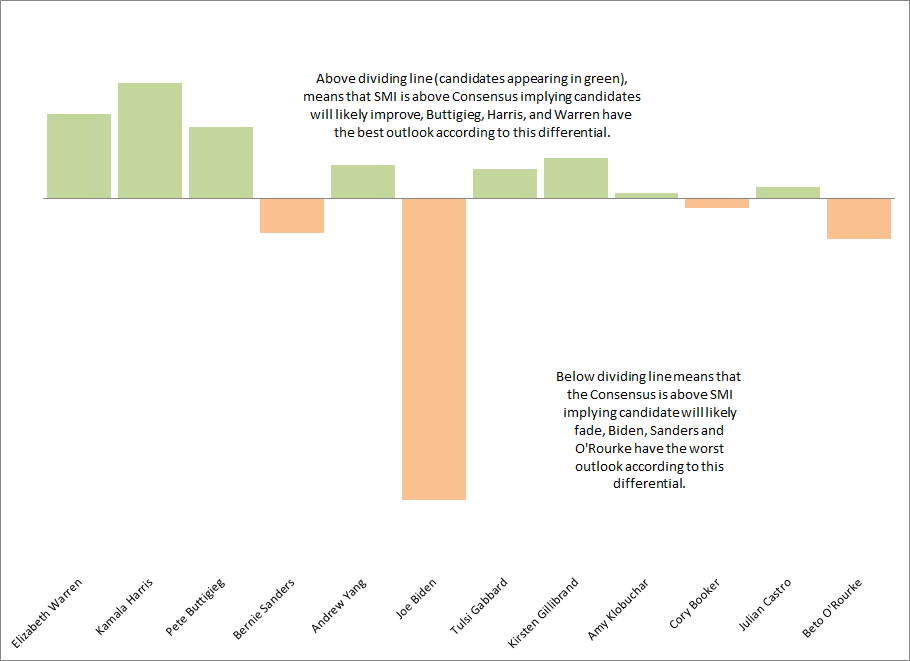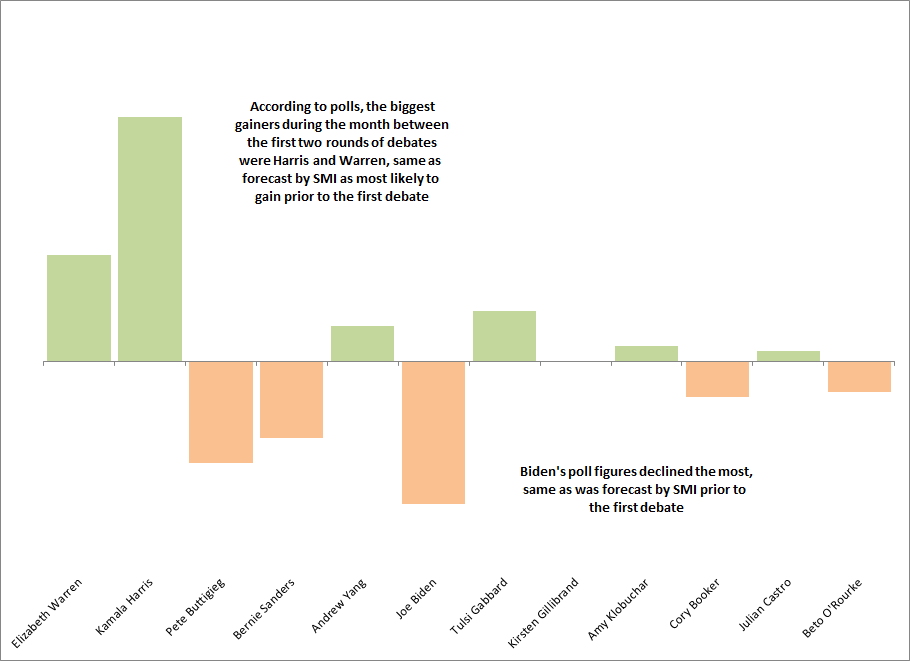Conclusion
So far, Social Media Influence (SMI) has performed extraordinarily well forecasting trends for the 2020 Democratic race.
As compared to the reactions of political analysts and to on-line surveys (questioning the winner of the first round of debates), ZettaCap’s forecasts made prior to the debates have been largely confirmed.
Perhaps the most impressive confirmation of the accuracy of ZettaCap’s forecasts is the change in polls over the last month since the first debate. When compared to ZettaCap’s pre-debate forecast, the change in polls clearly shows SMI as a leading indicator. Our chart depicting which candidates were expected to out-perform and which to under-perform almost exactly matches the trends in polls post-debate.
Exhibit 3 shows that 10 of the 11 SMI forecasts have been confirmed by the change in polls.
Immediate Post-Debate Performance vs Pre-Debate SMI Forecasts
Prior the first round of debates (June 26th and 27th), we published (June 24th) a report stating that, according to SMI, Biden looked extremely weak and would disappoint. Similarly, Sanders and O’Rourke were not expected to perform well due to weak SMIs.
On the positive side, we highlighted Harris, Buttitieg, and Warren as having the best positions going forward due to strong SMIs. In fact, prior to the debates, we stated that these three “candidates are the ones to watch to emerge post-debate as the consensus leaders.” Also, in the same report, Yang was highlighted as the “underdog favorite (entering) the debates with an unusually strong SMI as compared to his poll data” making him a likely out-performer.
Our forecasts appear to have been extremely accurate in the sense that the first round of debates has pushed up our positive group and down our negative group — showing that SMI appears to be working as a leading indicator.
Biden, Sanders, and O’Rourke have almost universally been seen as under-performing during the first round of debates. Their respective performances in post-debate on-line surveys were mediocre for such high-profile candidates. The case for Biden seems to have been especially shaken. For the first time since before the week Biden announced his candidacy, he lost the betting market leadership according to Predictit which has shown Harris leading Biden for much of the last month since the first debate.
In contrast, Harris and Warren were seen as two of the main winners from the debates. Not only did they generally perform well in on-line surveys asking which candidate won the debate but also saw their betting market probabilities improve post-debate. Further, political analysts declared them as part of the winning candidates at a variety of left-leaning publications as CNN, Vox, New York Times, and Rolling Stone.
The situation is more mixed with Yang. His performance was exceptional in terms of SMI where he placed third. Likewise, at least two on-line surveys on the night put him as the winner. However, his betting market probability collapsed five percentage points soon after the first debate which is a rather significant drop.
Two positive performances that were not forecast by SMI were those of Castro and Gabbard. Both appeared in the first night’s debate, with Castro placing first in SMI and in most of the rankings by traditional political analysts whereas Gabbard placed first in two of the on-line surveys.
Biggest Takeaways from First Debate vs Prior ZettaCap Forecasts
The two biggest takeaways from the first round of debates, at least according to our interpretation of consensus data and traditional analysis, appear to be:
- Surprising Strength of Kamala Harris, and
- Surprising Weakness of Joe Biden.
In both of these cases, SMI made straight-forward aggressive forecasts prior to the debates calling each.
On June 24, we wrote:
“Kamala could be the most underrated candidate of the Democrats as she has consistently produced strong SMI in the face of weakening consensus figures. Currently in second place for SMI, Harris has bounced around in the top three for months. She is definitely one to watch.”
On May 10, we wrote:
“ZettaCap expects Joe Biden to be the largest Democratic disappointment of the 22 candidate field. According to traditional metrics and pundit analysis, Biden is the likely nominee by a rather wide margin. According to Social Media Influence (SMI), Biden is in 4th place and struggling to maintain his position.”
Poll Changes vs Prior ZettaCap Forecasts
During multiple previous elections, we have pointed to SMI as a leading indicator for polls. Once again, this seems to be the case for the 2020 Democratic nomination.
We will show two charts. The first chart was published prior to the first debate and shows which candidates SMI predicted would improve and which would decline. This chart compared SMI to then-actual consensus figures which has worked well in other elections in forecasting coming poll trends.
The second chart shows the percentage point change in average poll figures (taken from Real Clear Politics) from just before the first round of debates (June 25th) to just before the second round of debates (July 25th).
In theory, these two charts should resemble one another, with the first being the forecast and the second being the actual result of poll shifts.
Exhibit 1: Social Media Influence (SMI) minus Consensus Indicator (appearing previously, published on June 24, 2019, so data is pre-debates)
Source: ZettaCap
Exhibit 2: Change in Average Poll Figures by Democratic Candidate, from June 25th (prior to first debate) to July 25th (prior to second debate)
Source: ZettaCap, Real Clear Politics Note: Relevant data for Gillibrand’s average polls were not available so is left blank.
These two charts show impressively similar patterns.
The SMI forecast (which appears in Exhibit 1 and which was published prior to the first debate) shows that Joe Biden was expected to be the biggest disappointment. This forecast is confirmed by his subsequent poll decline shown in Exhibit 2.
SMI also predicted (in Exhibit 1) that Harris and Warren would likely be the two largest out-performers, which was confirmed by their considerable poll boosts shown in Exhibit 2.
Considering the size of the field, getting the main trends for these important candidates would be a victory in terms of forecasting. Delving deeper, however, we see that 10 of the 11 forecasts came out correct when using one month change of polls as the confirming metric.
Exhibit 3: Comparing ZettaCap Forecast prior to first debate with one month Poll Change post-debate
| SMI Forecast | Actual Poll Change | Correct? | |
| Elizabeth Warren | Improve | Improve | Y |
| Kamala Harris | Improve | Improve | Y |
| Pete Buttigieg | Improve | Decline | N |
| Bernie Sanders | Decline | Decline | Y |
| Andrew Yang | Improve | Improve | Y |
| Joe Biden | Decline | Decline | Y |
| Tulsi Gabbard | Improve | Improve | Y |
| Amy Klobuchar | Improve | Improve | Y |
| Cory Booker | Decline | Decline | Y |
| Julian Castro | Improve | Improve | Y |
| Beto O’Rourke | Decline | Decline | Y |
Source: ZettaCap Note: Data based on previous exhibits
This last table clearly shows SMI’s ability to forecast poll trends ahead of time. In terms of directional change, it was correct in over 90% of the cases. And, for the top three candidates (Harris, Biden, and Warren) according to polls and betting markets, it was 100% correct.
Such a track-record is exceptional. Having shown how accurate SMI forecasts have been thus far in the 2020 election, we should note that past performance should not be seen as a guarantee of future performance.

